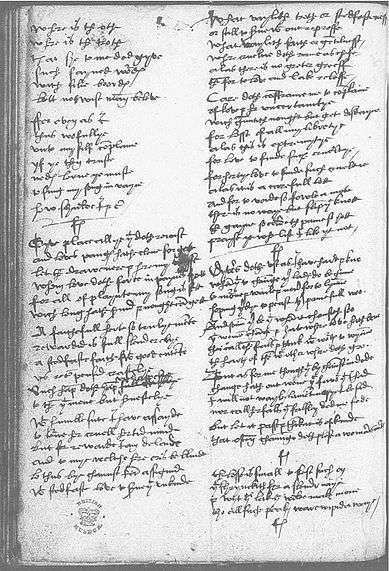|
Introduction | Contributors | Textual Introduction |
| ←Gyve place all ye that dothe reioise | the losse is small to lose suche on→ |
 The Devonshire Manuscript facsimile 77v |
f. [77v]
1 Dyvers dothe vse as I have hard & kno
2 {es}[[The Devonshire Manuscript/Appendix_I:_Paleographic_Features|{{th}'}]] {_u} [[The Devonshire Manuscript/Appendix_I:_Paleographic_Features|{{th}+t+}]] {_a} whanthat to chaunge1 their lades do beginne
3 to morne & waile & neuer{u'} for to lynne2
4 hoping there[[The Devonshire Manuscript/Appendix_I:_Paleographic_Features|{{th}'}]] bye to pease their[[The Devonshire Manuscript/Appendix_I:_Paleographic_Features|{{th}'}]] painefull woo.
5 {_a}[[The Devonshire Manuscript/Appendix_I:_Paleographic_Features|{{th}+t+}]] [[The Devonshire Manuscript/Appendix_I:_Paleographic_Features|{{th}'}]] {_i} And soimm there be that whan it chansithe soo
6 {_a}[[The Devonshire Manuscript/Appendix_I:_Paleographic_Features|{{th}+t+}]] that woman change & hate where love hath bene
7 {es}{w+t+} {_e} thei call them fals & think with wordesto wynne
8 {w+c+}{_e} {es} the hartes of themwhich other where dothe gro.
9 {_a}[[The Devonshire Manuscript/Appendix_I:_Paleographic_Features|{{th}+t+}]] But as for me though that by channse in dede
10 [[The Devonshire Manuscript/Appendix_I:_Paleographic_Features|{{th}+t+}]][[The Devonshire Manuscript/Appendix_I:_Paleographic_Features|{{th}+e+}]] change hathe out worne the favorthat I had
11 I will not wayle / lamen{_e}t noyr yet be sad
12 [[The Devonshire Manuscript/Appendix_I:_Paleographic_Features|{{th}+t+}]] nor call her fals that falsley ded me fede
13 but let it passe & thin{_i}k it is of kinde
14 {_i}{_a} {_u} {_e} that oftenn3 chaunnge doth plese a womans4 minde
fs
Notes & Glosses
1. See Petti.[1] A macron shaped with a curve and a dot beneath is an older form still in use in the 15th century.
2. The meaning of "to lynne" is "to cease."
3. The word "oftenn" is an example of a seemingly unnecessary indication of a supplied nasal.
4. See Petti.[2] A macron shaped as an ascending hook or curl is an ornamental form used in the 15th century.
Commentary
Attributed to Sir Thomas Wyatt,[3] this poem was entered by H8. In contrast to the common courtly love trope, the speaker refuses to complain about the fickleness of the lady, and justifies his refusal by remarking that womens' fickleness represents a part of "kinde" -- that is, a natural attribute of a woman's temperament. For another example describing this perspective concerning womens' fickleness, see the poem “Spight hathe no powre to make me sadde” (78r). Petrarch also touched on this theme of fickleness; in Rime 183, for instance, he writes: "Woman is by nature a changeable thing; whence I know well that a loving condition in the heart of woman lasts a very short time" (II, 12-14).[4]
This poem has the largest number of abbreviations in the entire manuscript.